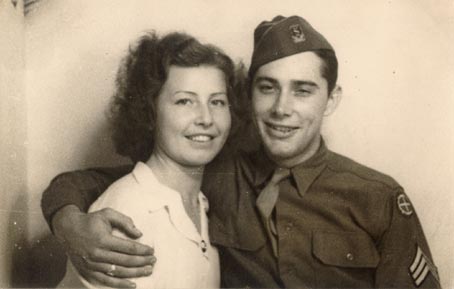| |
We continue
the story of the 35th Division in Europe with
the capture of St. Lo on the 19th of July, 1944.
That evening the exhausted 29th Division was pulled
back for a much needed rest and relieved by the
134th Infantry Regiment. The Germans had withdrawn
to a ridge about one mile South and to our front
and methodically fired artillery rounds into the
city which had already been devastated by aerial
bombing and heavy artillery. The next few days
the division flushed out snipers and small pockets
of resistance and watched the indomitable French
people come out of their basement hiding places
and filter back into their town, in spite of streets
filled with huge piles of debris that made them
almost impassable. On the brighter side we cleaned
up – ourselves, our weapons, equipment,
replenished ammunition and extended our three
regiments across the entire seven mile XIX corps
front along the South edge of St. Lo and along
the St. Lo-Bayeux Highway, with the 320th Infantry
on the left, 134th Infantry in the center, and
137th Infantry on the right. To our left was the
2nd Division, part of Gen. Gerow’s V Corps.
On our right was the 30th Division.
We had lost 2,500 men from our first ten days of combat, almost
16% of the division and many faces were missing, some of our longest
trained officers and best NCO’s Regiments, battalions, companies,
platoons, squads – all had to regroup under new commanders
who moved up to fill vacancies. A sobering and painful ritual without
much ceremony that followed every major engagement throughout the
war. It never got any easier. The frequent arrival of replacements
filled gaps but continually changed the makeup of the division.
Meanwhile we looked out southward to see that the German 3rd Parachute
Division and the tough 352nd Division were still out there waiting
for us.

War was not always tough
While there, the news of the aborted attempt
by German officers on Adolph Hitler’s life
spread among the troops and excited speculation
that this was a sign of an early termination of
the war. It raised morale but was not evident
in any signs of lessening resistance by our southerly
neighbors.
The capture of St. Lo brought greater security
to the beaches, and Gen. Bradley and Gen. Eisenhower
now felt that they had a sufficient striking force
in the lodgement area to attempt a breakout. There
were 12 American Infantry Divisions and three
Armored Divisions now in France with six more
on the way from the states. Along the front line
in Normandy facing South and extending from the
British sector westward were the following divisions:5th,
2nd, 35th, 30th, 9th, 83rd, 4th, Armored, 90th,
8th, and 79th Divisions. Behind the lines were
the 1st, 4th, 29th, and 2nd and 3rd Armored Divisions.
About to arrive were the 6th Armored Division,
28th and the French 2nd Armored Division, altogether
some 900,000 men under Gen. Bradley. To the East
around Caen were the British, Canadian and some
French and Polish units under Gen. Montgomery.
The 8th and 9th U.S. Air Forces and the R.A.F.
Bomber Command and Fighter Squadrons had secured
control of the skies over Normandy and for an
area over 100 miles behind the German lines, denying
the German Vehrmacht of free daylight movement
of troops and supplies, and limiting the Luftwaffe
to infrequent daylight sorties and reduced nighttime
bombing and fighter attacks. The 7th and 15th
German Armies were locked into defensive positions
and movement of tanks, infantry and supplies to
mount counter attacks or bring up reinforcements
forced German movements to be delayed until nighttime.
Behind the lines free French units and Freedom
Fighting Maquis, who had mobilized throughout
France, hampered transportation, destroyed bridges
and communications, and created a nightmare for
enemy troops.
 Continue
to Page 2 of 5 Continue
to Page 2 of 5
|